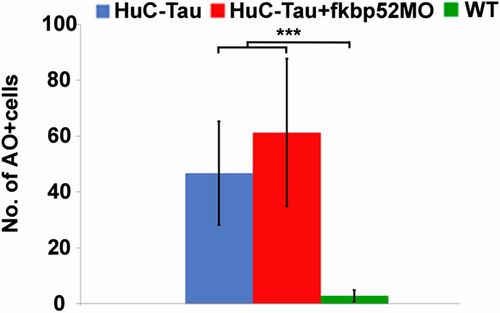- Title
-
Immunophilin FKBP52 induces Tau-P301L filamentous assembly in vitro and modulates its activity in a model of tauopathy
- Authors
- Giustiniani, J., Chambraud, B., Sardin, E., Dounane, O., Guillemeau, K., Nakatani, H., Paquet, D., Kamah, A., Landrieu, I., Lippens, G., Baulieu, E.E., Tawk, M.
- Source
- Full text @ Proc. Natl. Acad. Sci. USA
|
FKBP52 modulates pathological Tau activity in spinal primary motoneurons. (A–C) Lateral views of 48-hpf control embryos and FKBP52 morphant. Lateral views of znp1 antibody staining of control (D), FKBP52 morphant (E), Huc-Tau (F), and Huc-Tau injected with either FKBP52 MO (G) or FKBP52 mRNA (H) are shown at 48 hpf. (D2–H2) Tracings of motor-axon tracts ventral to the spinal cord derived from the panels directly above. In all images, anterior is to the left and dorsal is to the top. (Scale bars: A–C, 200 µm; D2–H2, 100 µm.) (I) Bar chart depicts the difference in the percentage of axons that reach their most ventral target. No significant difference is observed between WT and Huc-Tau + FKBP52MO embryos (N.S, P > 0.05; *P < 0.05; **P < 0.01). N.S, nonsignificant. PHENOTYPE:
|
|
Bar chart depicts the difference in the number of AO-positive cells. No significant difference was observed between the HuC-Tau and the HuC-Tau injected with FKBP52MO. A difference is observed when comparing these two groups and the WT siblings (***P ≤ 0.0001). PHENOTYPE:
|
|
Effect of FKBP52 knockdown on total and phosphorylated Tau in 48-h-old transgenic zebrafish expressing Tau-P301L. Total protein extract (2.5-5 µL) was loaded on 10% SDS/PAGE and analyzed by Western blotting using specific antibodies as indicated. Ctrl, control. EXPRESSION / LABELING:
|
|
Knockdown of FKBP52 improves larval mobility in HuC-Tau transgenics. (A-C) Tracking analyses of 48-hpf control (WT), Huc-Tau, and Huc-Tau + FKBP52MO larvae in a touch-response test. Each plot line represents the trajectory of one larva after touch stimulation. (D) Quantification of the touch-response test. Each group is divided into three categories: (a) embryos that do not respond at all, (b) embryos that move slightly upon stimulus, and (c) embryos that show a typical escape response. The locomotor defects are significantly improved in Huc-Tau larvae injected with 0.4 pmol of FKBP52 MO (Kruskal-Wallis test,***P < 0.0001). PHENOTYPE:
|
|
FKBP52 is expressed ubiquitously in the nervous system in zebrafish. (A) Sequence alignment of Danio rerio (Z) and human (H) FKBP52. D. rerio FKBP52 amino acid sequence shares 62% of identities (amino acids in red) and 83% of homologies with the human ortholog. Based on the 3D structure of human FKBP52 (1), four domains are delineated. The single underlining indicates peptidyl-prolyl isomerase (PPIase) and FK506-binding domain, the double underlining indicates PPIase-like domain, the thick underlining indicates tetratricopetide repeat domain, and the dashed underlining indicates calmodulin binding domain. (B) RT-PCR shows the expression of FKBP52 during development. NCtrl, negative control. (C) Whole-mount FKBP52 in situ hybridization shows its maternal ubiquitous expression [1.25 h postfertilization (hpf)] that persists until 32 hpf. (Scale bars: 200 µm.) |





